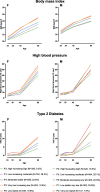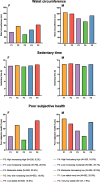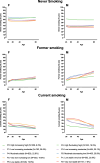Longitudinal leisure-time physical activity profiles throughout adulthood and related characteristics: a 36-year follow-up study of the older Finnish Twin Cohort
- PMID: 38671483
- PMCID: PMC11046842
- DOI: 10.1186/s12966-024-01600-y
Longitudinal leisure-time physical activity profiles throughout adulthood and related characteristics: a 36-year follow-up study of the older Finnish Twin Cohort
Abstract
Background: Personalized interventions aiming to increase physical activity in individuals are effective. However, from a public health perspective, it would be important to stimulate physical activity in larger groups of people who share the vulnerability to be physically inactive throughout adulthood. To find these high-risk groups, we identified 36-year leisure-time physical activity profiles from young adulthood to late midlife in females and males. Moreover, we uncovered which anthropometric-, demographic-, lifestyle-, and health-related characteristics were associated with these physical activity profiles.
Methods: We included 2,778 females and 1,938 males from the population-based older Finnish Twin Cohort Study, who responded to health and behavior surveys at the mean ages of 24, 30, 40 and 60. Latent profile analysis was used to identify longitudinal leisure-time physical activity profiles.
Results: We found five longitudinal leisure-time physical activity profiles for both females and males. Females' profiles were: 1) Low increasing moderate (29%), 2) Moderate stable (23%), 3) Very low increasing low (20%), 4) Low stable (20%) and 5) High increasing high (9%). Males' profiles were: 1) Low increasing moderate (29%), 2) Low stable very low (26%), 3) Moderate decreasing low (21%), 4) High fluctuating high (17%) and 5) Very low stable (8%). In both females and males, lower leisure-time physical activity profiles were associated with lower education, higher body mass index, smoking, poorer perceived health, higher sedentary time, high blood pressure, and a higher risk for type 2 diabetes. Furthermore, lower leisure-time physical activity was linked to a higher risk of depression in females.
Conclusions: We found several longitudinal leisure-time physical activity profiles with unique changes in both sexes. Fewer profiles in females than in males remained or became low physically active during the 36-year follow-up. We observed that lower education, higher body mass index, and more smoking already in young adulthood were associated with low leisure-time physical activity profiles. However, the fact that several longitudinal profiles demonstrated a change in their physical activity behavior over time implies the potential for public health interventions to improve leisure-time physical activity levels.
Keywords: Exercise; Latent classes; Longitudinal; Sports; Working-age individuals.
© 2024. The Author(s).
Conflict of interest statement
The authors declare no conflicts of interest.
Figures




Similar articles
-
Association between education and future leisure-time physical inactivity: a study of Finnish twins over a 35-year follow-up.BMC Public Health. 2016 Aug 4;16:720. doi: 10.1186/s12889-016-3410-5. BMC Public Health. 2016. PMID: 27492437 Free PMC article.
-
Leisure-time physical inactivity and association with body mass index: a Finnish Twin Study with a 35-year follow-up.Int J Epidemiol. 2017 Feb 1;46(1):116-127. doi: 10.1093/ije/dyw007. Int J Epidemiol. 2017. PMID: 26979986
-
Associations of sitting time with leisure-time physical inactivity, education, and body mass index change.Scand J Med Sci Sports. 2020 Feb;30(2):322-331. doi: 10.1111/sms.13575. Epub 2019 Oct 24. Scand J Med Sci Sports. 2020. PMID: 31605629
-
The relationship between leisure time, physical activities and musculoskeletal symptoms and disability in worker populations.Int Arch Occup Environ Health. 2000 Nov;73(8):507-18. doi: 10.1007/s004200000167. Int Arch Occup Environ Health. 2000. PMID: 11100945 Review.
-
Types of leisure-time physical activity participation in childhood and adolescence, and physical activity behaviours and health outcomes in adulthood: a systematic review.BMC Public Health. 2024 Jul 4;24(1):1789. doi: 10.1186/s12889-024-19050-3. BMC Public Health. 2024. PMID: 38965532 Free PMC article.
References
-
- Lounassalo I, Salin K, Kankaanpaa A, Hirvensalo M, Palomaki S, Tolvanen A, et al. Distinct trajectories of physical activity and related factors during the life course in the general population: a systematic review. BMC Public Health. 2019;19(1):271. doi: 10.1186/s12889-019-6513-y. - DOI - PMC - PubMed
Publication types
MeSH terms
Grants and funding
LinkOut - more resources
Full Text Sources

